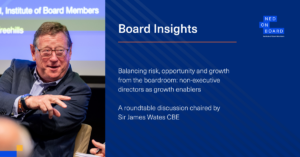Toys Are Us? Blockbuster? Kodak? Or Amazon? What do the first three companies have in common?
They no longer exist. This is because they all were stuck in a way of working, or an existing product and couldn’t adapt to change. Not Amazon – it just gets more and more successful each year.
Change management is vital for the survival of almost every sector in the world right now. Think of clothing, groceries, entertainment, books – the list is almost endless. Non-excutive board members must be at the forefront of championing change in their own company. Too often, I have seen boards stuck in the past and therefore endangering the organisation’s future.Non-execs come with a range of professional skills and experience, but that’s not where the learning ends. Non-execs in particular must be willing and open to learning for the rest of their career.
It was a business professor in 1963 at Louisiana State University, name Leon C Megginson, who paraphrased Charles Darwin:
It is not the most intellectual of the species that survives; it is not the strongest that survives; but the species that survives is the one that is able to adapt to and to adjust best to the changing environment in which it finds itself.
Adapting to change or spearheading change are the most valuable skills a NED can possess – because the world is changing rapidly.
Just last month NEDonboard hosted an event on all aspects of IT – Blockchain, Artificial Intelligence and Cyber Security. Your role on the board is to ensure each of these are considered, if not fully investigated. There are various reports about the loss of up to 50% of jobs in the next 20 – 30 years. How will this help or hinder your business?
That’s just one of the upcoming changes. Globalisation is blamed for the ongoing disruption in the world today: Brexit, trade wars, migration – the list is added to almost on a weekly basis. The financial crash was only 10 years ago. How are we, as NED leaders, going to manage the change coming our way?
So if change is the new normal, how do we ensure it is effected successfully with the least amount of disruption (if that’s not a contradiction!)? People don’t like change and therefore, even if you recognise the uncertainties, your fellow board members and CEOs may not. This leads to resistance. There are lots of articles written about resistance to change and the one below is from Rosabeth Moss Kanter, professor at Harvard Business School and chair and director of the Harvard Advanced Leadership Initiative.
The best tool for leaders of change is to understand the predictable, universal sources of resistance in each situation and then strategize around them. Here are the ten I’ve found to be the most common.
Loss of control. Our sense of self-determination is often the first things to go when faced with a potential change coming from someone else. Smart leaders leave room for those affected by change to make choices. They invite others into the planning, giving them ownership.
Excess uncertainty To overcome inertia requires a sense of safety as well as an inspiring vision. Leaders should create certainty of process, with clear, simple steps and timetables.
Surprise, surprise! It’s always easier to say No than to say Yes. Leaders should avoid the temptation to craft changes in secret and then announce them all at once. It’s better to plant seeds — that is, to sprinkle hints of what might be coming and seek input.
Everything seems different We are creatures of habit. Routines become automatic, but change jolts us into consciousness, sometimes in uncomfortable ways. Leaders should try to minimize the number of unrelated differences introduced by a central change.
Loss of face When change involves a big shift of strategic direction, the people responsible for the previous direction dread the perception that they must have been wrong. Leaders can help people maintain dignity by celebrating those elements of the past that are worth honouring, and making it clear that the world has changed.
Concerns about competence. Can I do it? Change is resisted when it makes people feel stupid. Leaders should over-invest in structural reassurance, providing abundant information, education, training, mentors, and support systems.
More work. Change is indeed more work. Those closest to the change in terms of designing and testing it are often overloaded, in part because of the inevitable unanticipated glitches in the middle of change, per “Kanter’s Law” that “everything can look like a failure in the middle.” Leaders should acknowledge the hard work of change by allowing some people to focus exclusively on it, or adding extra perks for participants (meals? valet parking? massages?).
Ripple effects. Like tossing a pebble into a pond, change creates ripples, reaching distant spots in ever-widening circles. The ripples disrupt other departments, important customers, people well outside the venture or neighbourhood, and they start to push back, rebelling against changes they had nothing to do with that interfere with their own activities. Leaders should enlarge the circle of stakeholders. They must consider all affected parties, however distant, and work with them to minimize disruption.
Past resentments. The ghosts of the past are always lying in wait to haunt us. As long as everything is steady state, they remain out of sight. But the minute you need cooperation for something new or different, the ghosts spring into action. Leaders should consider gestures to heal the past before sailing into the future.
Sometimes the threat is real. Now we get to true pain and politics. Change is resisted because it can hurt. When new technologies displace old ones, jobs can be lost; prices can be cut; investments can be wiped out. The best thing leaders can do when the changes they seek pose significant threat is to be honest, transparent, fast, and fair. For example, one big layoff with strong transition assistance is better than successive waves of cuts.’
I hope you realise how very difficult change can be, and that it’s not all about social media. The key idea here is that the world has changed and will continue to change. Is your Board up for the challenge?
Related post: The role of boards and NEDs in driving innovation
Written by Pat Fitzsimons, a change management professional, working in the charitable sector to improve management and governance in the sector.




